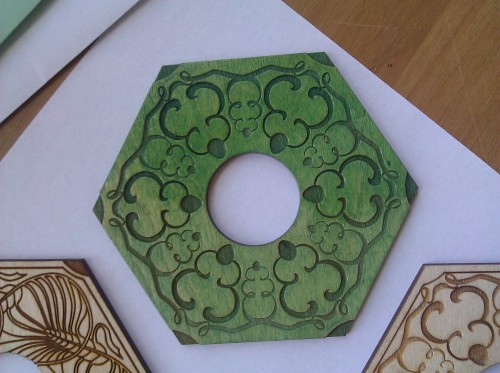Several times, I've had it suggested that I should try coloring the tiles. I've been a little skeptical, but I tried an experiment. I took a sheep tile and got some green wood stain from Cole's Hardware and went to work. I doubled the coat on half the tile, you should be able to see the difference in the pic.
Personally, I don't like it. A lot of the beauty comes from the wood, and the stain seems to just cover it up. I'm planning on making tile sets available so if you disagree, please buy one and stain it. Maybe my technique is wrong and I just need someone to show me how it's done.




 The Dominion Caddy
The Dominion Caddy The Catan Board
The Catan Board The Pips
The Pips The Robber
The Robber The Frame
The Frame The Tiles
The Tiles

Doesn’t look bad, but not nearly as good as pure. What if you stained only the unetched layer? The dark is where the magic is.
LikeLike
I do think that it’s not easy to visually differentiate the tiles without some color somewhere on it — I think it may be part of why you won all the games at that event 😉
LikeLike
I think quite the opposite, i think the stained piece looks better where it has been etched. I like the darker less brown effect it makes. Although I think the unetched parts look rather drab. Also, I can see the aesthetic quality varying depending on the colour used.
LikeLike
i agree they dont look as nice as a work of art but when you play the game i think they will make it so much easier to quickly identify the tiles and at the end of the day i think that might be better.
LikeLike
Ok, ok, I’m inspired. How about this idea: I could offer some MDF tiles (MDF is way cheaper than birch) for people to paint at home. This will let me offer a less expensive kickstarter reward, people would get a full set of hexes with pretty designs, and be able to colour them. Granted, it would be a bit of a DIY effort on their part, but not too bad.
LikeLike
I love this idea!
LikeLike
I don’t think leaving coloring as DIY is the best way to maximize success. When your customer fails to stain properly and ruins their tile, they won’t be happy customers.
LikeLike
Pardon me for saying, but I think you have that backwards. If a customer “ruins” their own tiles then they have no one to blame but themselves. And anyway, can’t they just remove the stain with some wood bleach and start over? In any case, I can’t see how Mr. Brown’s success is tied to him staining it. If they don’t like it when it arrives, he’ll end up bearing the blame and likely eat the cost of any unhappy returns. Not exactly measures of “success”.
LikeLike
Ramone, I think you’re both right. I want customers to have only good experiences from buying the product. That means I should aim to eliminate even the *possibility* that they have a bad experience, even at their own hand.
That said, you’re exactly correct, if I ship stained tiles that don’t meet my own standards of awesomeness, I will not be making a good name for myself and will probably have to endure customer returns.
LikeLike
I don’t know much about wood costs, especially as it relates to your needs, but is it possible to just use a couple different kinds of wood? The point isn’t necessarily to have your colors match the normal colors as much as the point is to have different colors to be able to tell the tiles apart. You could use some kind of red wood for the clay, a nice light wood for the weak, a dark wood for the stone, and then something interesting for the sheep and wood.
LikeLike
Yeah, I even have an option for that in my Kickstarter project. It’s called the Fancywood Edition.
LikeLike
Ooh, what a wonderful solution to the contrast issue!
LikeLike
What about adding accent colors as in this custom board: http://scoobasteve.co.nz/wp-content/uploads/Catan_02.jpg.
I also like the realistic coastline.
LikeLike